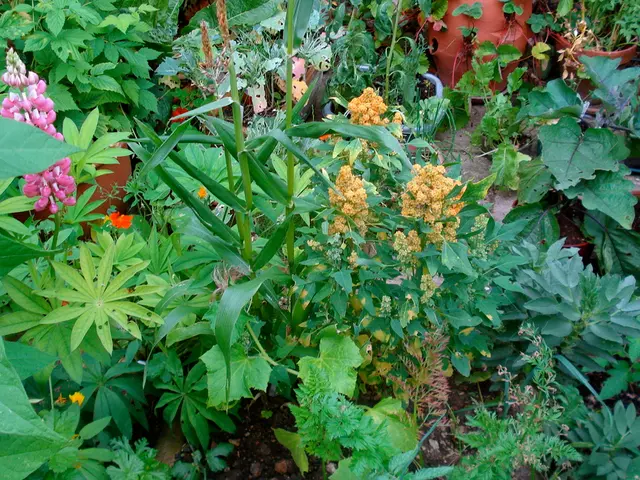Successfully Growing an Easter Lily Outdoors: A Step-by-Step Guide
Alright, let's talk Easter lilies, shall we? Every year around Pascha, we adorn our homes with these big, gorgeous, and fragrant blooms, like the Lilium longiflorum, commonly known as Easter lilies. But once these beauties fade, you might wonder if you can plant an Easter lily outside. Well, that depends on a few factors, including your local climate and planting zone, as well as how you maintain the plant. In this guide, we'll help you successfully plant an Easter lily out in your garden for more blossoms next year.
Time to Prep the Lily
After your Easter lily has completed its indoor show, it's time to prepare it for life outside. Snip off the wilted flowers, but keep the leaves intact as they'll help the plant transform sunlight into energy for next year's bulb. Keep watering and fertilizing your lily just like you do with all your indoor plants until it goes outside.
Await the Frost's Departure
Leave your potted Easter lily basking in a sunny window until the frost threat in your area subsides. Pay attention to the weather and find out your area's last frost date to know when it's warm enough to plant outside. Planting too early could result in damage from chilly temperatures.
Hardening Off the Easter Lily
Once frost is no longer a worry, slowly acclimate your plant to outdoor conditions by hardening it off in the shade for a few days. Gradually expose it to increasing amounts of direct sunlight over about a week to minimize transplant shock and sunscald on the leaves.
Find the Perfect Spot
Once you liberate the plant from its container and loosen its root system, plant it about 6 inches deep in a location that has well-drained soil and morning sunlight. Water well to help the soil settle around the roots.
Mulch, Baby, Mulch
Keep the lily's roots cool during summer by applying 2 inches of mulch over the soil surface. Choose the best mulch to shade roots on hot days, prevent moisture from evaporating, and prevent weeds from establishing themselves.
Say Goodbye to Old Growth
After planting your Easter lily outside, its leaves and stem will die back. Remove the plant's old tops once they wither up to make way for new growth. You may see new shoots this summer, but you might not see any new shoots until next June.
Winterize Your Easter Lily, If Needed
If winter in your area is especially frigid, you can winterize your Easter lily bulb by covering the plant with a blanket of mulch to insulate its roots from extreme temperatures. A few inches of loose organic mulch, like shredded leaves, bark chips, pine needles, or straw, will do the trick.
Most types of Easter lilies are hardy in USDA Hardiness Zones 5 to 11. If you live in colder regions, consider digging up the bulbs in fall and storing them indoors until early spring.
Spring Cleaning for Your Easter Lily
If the weather cooperates, your Easter lily may spring back to life in the spring for a few years. Remove the blanket of mulch to allow new growth to emerge and enjoy the beautiful blooms of your Easter lily once again.
Frequently Asked Questions
- Do Easter lilies multiply when planted outdoors? Yep, they multiply over time, and eventually, you'll find small bulbs surrounding the main bulb. Separate the small bulbs while keeping their roots intact and replant them in a different location. The division should ideally be done in early spring before the plant starts growing or in the fall after it dies back.
- Do Easter lilies bloom more than once a year? While most Easter lilies bloom once a year in spring, a few may bloom again in the fall under optimal conditions.
- Should I deadhead my Easter lily? Pruning off faded Easter lily blooms keeps your plant tidy and more attractive, plus it helps the bulb store energy for the following year. However, it doesn't induce reblooming like it does for some plants.
- After the Easter lily's indoor display, snip off wilted flowers and keep the leaves to help the plant store energy for next year's bulb.
- Wait for the frost threat to subside in your area before planting the potted Easter lily outside, considering the local climate and planting zone.
- Gradually expose the plant to outdoor conditions by hardening it off in the shade for a few days, then increasing direct sunlight over about a week.
- Plant the Easter lily in a location with well-drained soil and morning sunlight, about 6 inches deep, once it's acclimated to outdoor conditions and frost is no longer a concern.
- Keep the roots cool during summer by applying mulch over the soil surface to shield them from hot temperatures, prevent moisture evaporation, and deter weed growth.
- Remove the old tops of the Easter lily once they wither up to make way for new growth, and winterize the bulb with mulch if necessary in colder regions.







